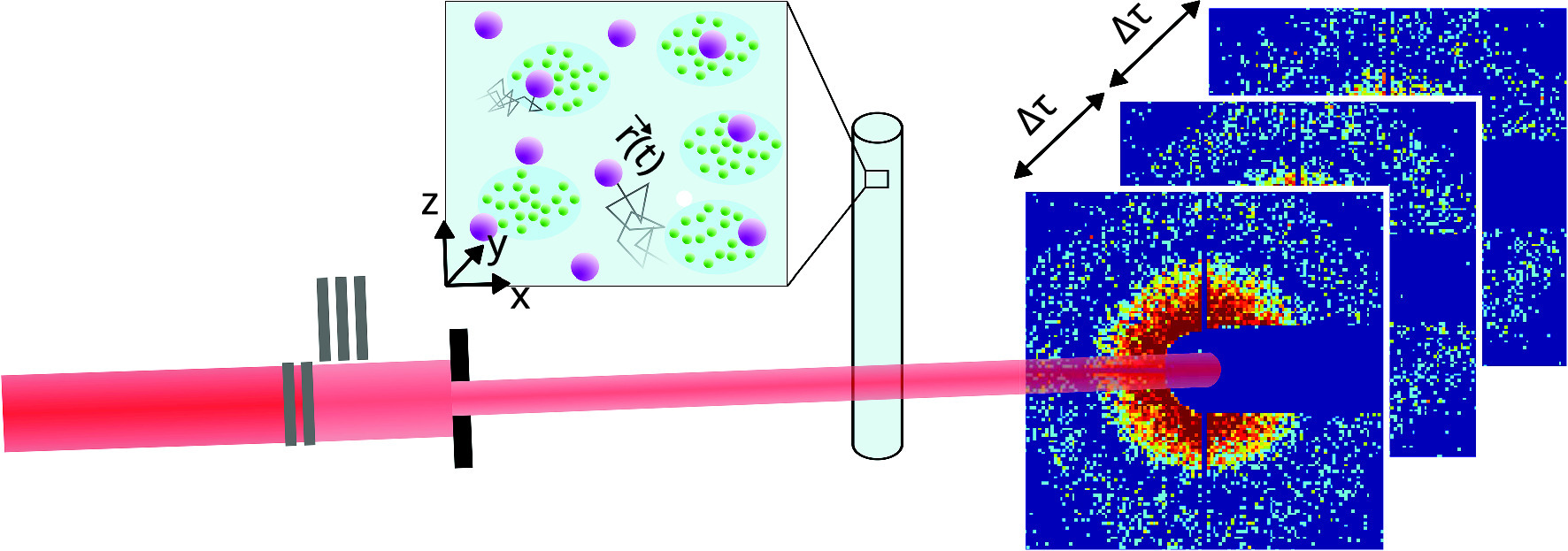https://doi.org/10.1140/epje/s10189-023-00375-7
Regular Article – Flowing Matter
Lipid vesicle pools studied by passive X-ray microrheology
1
Institut für Röntgenphysik, Georg-August-Universität Göttingen, 37077, Göttingen, Germany
2
European Synchrotron Radiation Facility, 38043, Grenoble Cedex 9, France
3
Laboratory of Molecular Neuroscience, German Center for Neurodegenerative Diseases (DZNE), 10117, Berlin, Germany
Received:
4
August
2023
Accepted:
7
November
2023
Published online:
7
December
2023
Vesicle pools can form by attractive interaction in a solution, mediated by proteins or divalent ions such as calcium. The pools, which are alternatively also denoted as vesicle clusters, form by liquid-liquid phase separation (LLPS) from an initially homogeneous solution. Due to the short range liquid-like order of vesicles in the pool or cluster, the vesicle-rich phase can also be regarded as a condensate, and one would like to better understand not only the structure of these systems, but also their dynamics. The diffusion of vesicles, in particular, is expected to change when vesicles are arrested in a pool. Here we investigate whether passive microrheology based on X-ray photon correlation spectroscopy (XPCS) is a suitable tool to study model systems of artificial lipid vesicles exhibiting LLPS, and more generally also other heterogeneous biomolecular fluids. We show that by adding highly scattering tracer particles to the solution, valuable information on the single vesicle as well as collective dynamics can be inferred. While the correlation functions reveal freely diffusing tracer particles in solutions at low CaCl concentrations, the relaxation rate
concentrations, the relaxation rate  shows a nonlinear dependence on
shows a nonlinear dependence on  at a higher concentration of around 8 mM CaCl
at a higher concentration of around 8 mM CaCl , characterised by two linear regimes with a broad cross-over. We explain this finding based on arrested diffusion in percolating vesicle clusters.
, characterised by two linear regimes with a broad cross-over. We explain this finding based on arrested diffusion in percolating vesicle clusters.
This manuscript is dedicated to Fyl Pincus, who provided valuable mentoring and scientific advice and perspective, much enriching the postdoctoral research of Tim Salditt in Santa Barbara.
Supplementary Information The online version contains supplementary material available at https://doi.org/10.1140/epje/s10189-023-00375-7.
© The Author(s) 2023
 Open Access This article is licensed under a Creative Commons Attribution 4.0 International License, which permits use, sharing, adaptation, distribution and reproduction in any medium or format, as long as you give appropriate credit to the original author(s) and the source, provide a link to the Creative Commons licence, and indicate if changes were made. The images or other third party material in this article are included in the article’s Creative Commons licence, unless indicated otherwise in a credit line to the material. If material is not included in the article’s Creative Commons licence and your intended use is not permitted by statutory regulation or exceeds the permitted use, you will need to obtain permission directly from the copyright holder. To view a copy of this licence, visit http://creativecommons.org/licenses/by/4.0/.
Open Access This article is licensed under a Creative Commons Attribution 4.0 International License, which permits use, sharing, adaptation, distribution and reproduction in any medium or format, as long as you give appropriate credit to the original author(s) and the source, provide a link to the Creative Commons licence, and indicate if changes were made. The images or other third party material in this article are included in the article’s Creative Commons licence, unless indicated otherwise in a credit line to the material. If material is not included in the article’s Creative Commons licence and your intended use is not permitted by statutory regulation or exceeds the permitted use, you will need to obtain permission directly from the copyright holder. To view a copy of this licence, visit http://creativecommons.org/licenses/by/4.0/.






